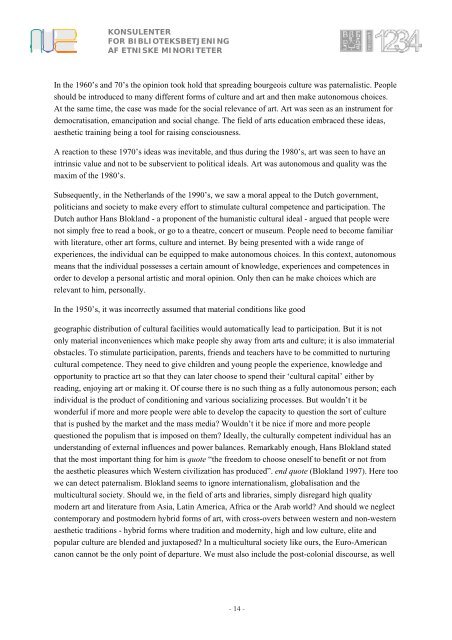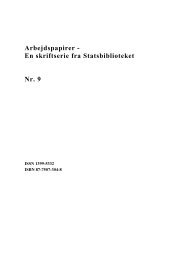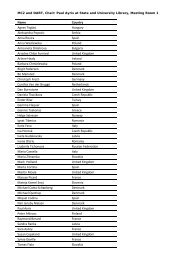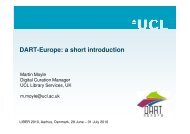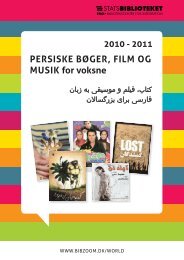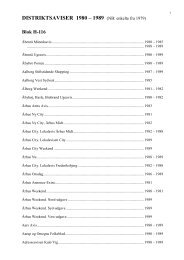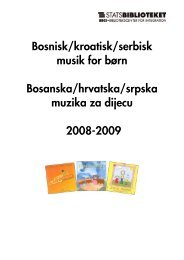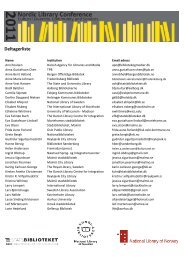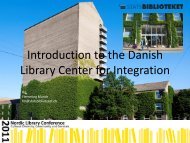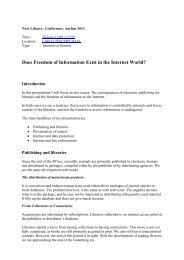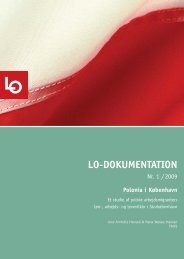Konference om Integration, kultur og biblioteker - Statsbiblioteket
Konference om Integration, kultur og biblioteker - Statsbiblioteket
Konference om Integration, kultur og biblioteker - Statsbiblioteket
You also want an ePaper? Increase the reach of your titles
YUMPU automatically turns print PDFs into web optimized ePapers that Google loves.
KONSULENTER<br />
FOR BIBLIOTEKSBETJENING<br />
AF ETNISKE MINORITETER<br />
In the 1960’s and 70’s the opinion took hold that spreading bourgeois culture was paternalistic. People<br />
should be introduced to many different forms of culture and art and then make auton<strong>om</strong>ous choices.<br />
At the same time, the case was made for the social relevance of art. Art was seen as an instrument for<br />
democratisation, emancipation and social change. The field of arts education embraced these ideas,<br />
aesthetic training being a tool for raising consciousness.<br />
A reaction to these 1970’s ideas was inevitable, and thus during the 1980’s, art was seen to have an<br />
intrinsic value and not to be subservient to political ideals. Art was auton<strong>om</strong>ous and quality was the<br />
maxim of the 1980’s.<br />
Subsequently, in the Netherlands of the 1990’s, we saw a moral appeal to the Dutch government,<br />
politicians and society to make every effort to stimulate cultural c<strong>om</strong>petence and participation. The<br />
Dutch author Hans Blokland - a proponent of the humanistic cultural ideal - argued that people were<br />
not simply free to read a book, or go to a theatre, concert or museum. People need to bec<strong>om</strong>e familiar<br />
with literature, other art forms, culture and internet. By being presented with a wide range of<br />
experiences, the individual can be equipped to make auton<strong>om</strong>ous choices. In this context, auton<strong>om</strong>ous<br />
means that the individual possesses a certain amount of knowledge, experiences and c<strong>om</strong>petences in<br />
order to develop a personal artistic and moral opinion. Only then can he make choices which are<br />
relevant to him, personally.<br />
In the 1950’s, it was incorrectly assumed that material conditions like good<br />
ge<strong>og</strong>raphic distribution of cultural facilities would aut<strong>om</strong>atically lead to participation. But it is not<br />
only material inconveniences which make people shy away fr<strong>om</strong> arts and culture; it is also immaterial<br />
obstacles. To stimulate participation, parents, friends and teachers have to be c<strong>om</strong>mitted to nurturing<br />
cultural c<strong>om</strong>petence. They need to give children and young people the experience, knowledge and<br />
opportunity to practice art so that they can later choose to spend their ‘cultural capital’ either by<br />
reading, enjoying art or making it. Of course there is no such thing as a fully auton<strong>om</strong>ous person; each<br />
individual is the product of conditioning and various socializing processes. But wouldn’t it be<br />
wonderful if more and more people were able to develop the capacity to question the sort of culture<br />
that is pushed by the market and the mass media? Wouldn’t it be nice if more and more people<br />
questioned the populism that is imposed on them? Ideally, the culturally c<strong>om</strong>petent individual has an<br />
understanding of external influences and power balances. Remarkably enough, Hans Blokland stated<br />
that the most important thing for him is quote “the freed<strong>om</strong> to choose oneself to benefit or not fr<strong>om</strong><br />
the aesthetic pleasures which Western civilization has produced”. end quote (Blokland 1997). Here too<br />
we can detect paternalism. Blokland seems to ignore internationalism, globalisation and the<br />
multicultural society. Should we, in the field of arts and libraries, simply disregard high quality<br />
modern art and literature fr<strong>om</strong> Asia, Latin America, Africa or the Arab world? And should we neglect<br />
contemporary and postmodern hybrid forms of art, with cross-overs between western and non-western<br />
aesthetic traditions - hybrid forms where tradition and modernity, high and low culture, elite and<br />
popular culture are blended and juxtaposed? In a multicultural society like ours, the Euro-American<br />
canon cannot be the only point of departure. We must also include the post-colonial discourse, as well<br />
- 14 -


